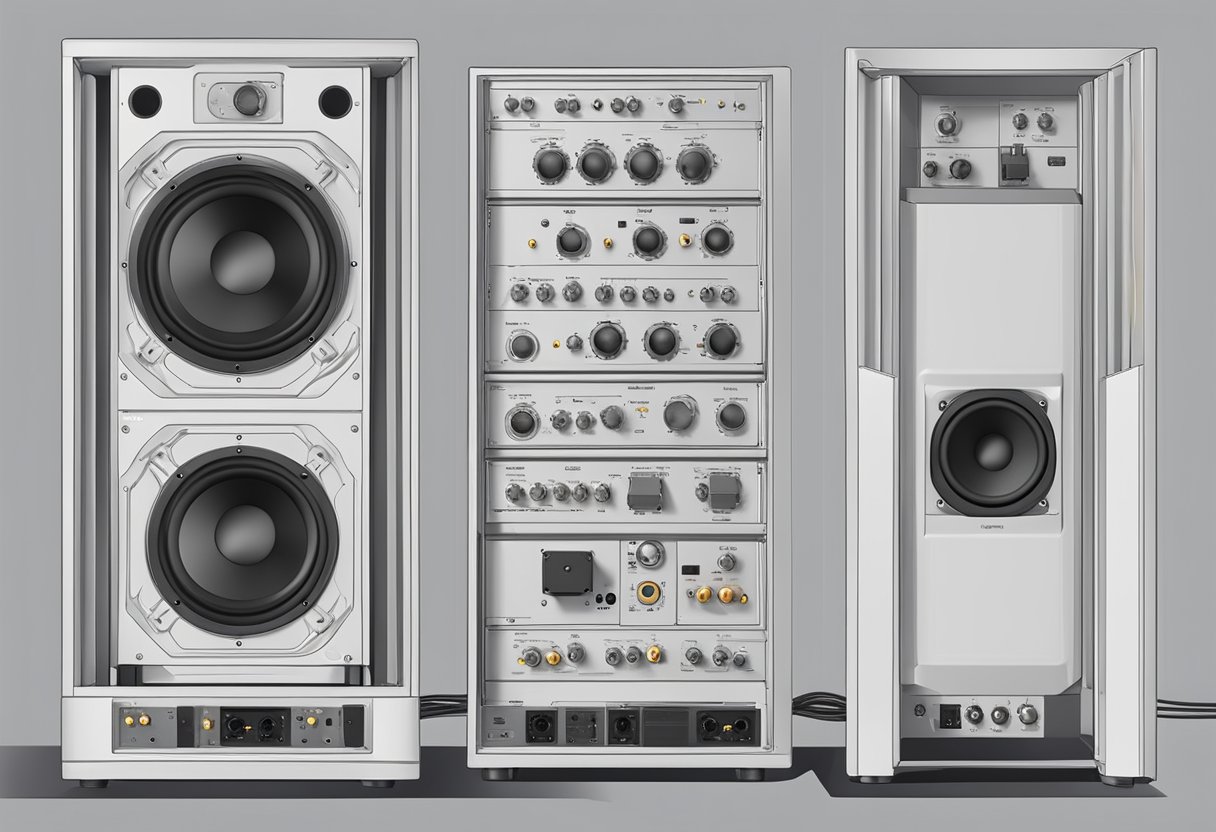Subwoofers are an essential component of any home theater or audio system. They provide the low-frequency sounds that are necessary to create an immersive listening experience.
One of the most important features of a subwoofer is its input options, and one of the most versatile options is speaker level inputs.
Speaker level inputs allow the subwoofer to receive a signal directly from the amplifier or receiver, which means that no additional cables or connections are required. This makes it a convenient option for those who want to add a subwoofer to an existing system without having to rewire everything.
In addition, speaker level inputs are often preferred by audiophiles because they can provide a cleaner and more natural sound than other input options.
When it comes to subwoofers with speaker level inputs, there are many options available on the market. Some of the top brands produce subs with this feature, including Polk, Bowers & Wilkins, Klipsch, and many others.
It’s important to choose a subwoofer with the right input options for your system, and speaker level inputs can be a great choice for many people.
Key Takeaways
- Subwoofers with speaker level inputs are a convenient option for adding a subwoofer to an existing system without additional cables or connections.
- Speaker level inputs can provide a cleaner and more natural sound than other input options.
- Many top brands produce subwoofers with speaker level inputs, making it easy to find the right option for your system.
Understanding Subwoofers
Subwoofers are specialized speakers that are designed to reproduce low-frequency sounds, such as bass and sub-bass. They are commonly used in home theater systems and music systems to enhance the overall sound quality.
Subwoofers are available in different types, including powered subwoofers and passive subwoofers.
Types of Subwoofer Connections
Subwoofers can be connected to a sound system in different ways. The most common types of subwoofer connections are low-level connection and high-level connection.
A low-level connection involves connecting the subwoofer to the sub output of a receiver or amplifier using an RCA cable. This type of connection is ideal for powered subwoofers, which have their own built-in amplifiers.
A high-level connection involves connecting the subwoofer to the speaker outputs of a receiver or amplifier using speaker wire. This type of connection is ideal for passive subwoofers, which do not have their own built-in amplifiers.
Wireless subwoofers are also available, which use a wireless transmitter to send the audio signal to the subwoofer.
Subwoofer Specifications
When choosing a subwoofer, it is important to consider its specifications, such as the crossover frequency and subwoofer filter.
The crossover frequency is the frequency at which the subwoofer takes over from the main speakers. It is important to set the crossover frequency correctly to ensure a smooth transition between the main speakers and the subwoofer.
The subwoofer filter is used to adjust the bass output of the subwoofer. It can be used to boost or cut the bass frequencies to match the room acoustics and personal preferences.
Integrating Subwoofers with Speakers
When it comes to integrating subwoofers with speakers, there are a few things to keep in mind. In this section, we will explain what speaker level inputs are and how to connect your subwoofer to speaker outputs.
Speaker Level Inputs Explained
Speaker level inputs are a type of high-level audio connection that allows you to connect your subwoofer to your amplifier or receiver using speaker wire.
This means that you can use the same speaker wire that you use to connect your speakers to your amplifier or receiver to connect your subwoofer as well.
Speaker level inputs are useful because they allow you to easily integrate your subwoofer with your speakers without having to use a separate cable or connection type. They also allow you to adjust the volume of your subwoofer using the same volume control that you use for your speakers.
Connecting Your Subwoofer to Speaker Outputs
To connect your subwoofer to speaker outputs, you will need to follow a few simple steps.
First, you will need to locate the speaker-level output on your amplifier or receiver. This is usually labeled as “speaker-level output” or “high-level output.”
Once you have located the speaker-level output, you will need to connect one end of your speaker wire to the output and the other end to the input on your subwoofer.
Make sure to connect the left and right audio channels to the corresponding inputs on your subwoofer.
After you have connected your subwoofer to your amplifier or receiver, you will need to adjust the gain on your subwoofer to match the output level of your amplifier or receiver.
This will ensure that your subwoofer is producing the correct amount of bass without overpowering your speakers.
Optimizing Subwoofer Performance
When it comes to getting the most out of your subwoofer with speaker level inputs, there are a few key things to keep in mind. By optimizing your subwoofer’s performance, you can ensure that you’re getting the best possible sound quality for your music and movies.
Setting Crossover and Phase Control
One of the most important things to consider when setting up your subwoofer is the crossover. This is the frequency at which your subwoofer begins to kick in and take over from your main speakers.
By setting the crossover correctly, you can ensure that your subwoofer is working in harmony with your main speakers, rather than overpowering them.
Another important setting to consider is the phase control. This determines the timing of the audio signals sent to your subwoofer.
By adjusting the phase control, you can ensure that your subwoofer is in sync with the rest of your audio system, resulting in a more natural bass response.
Troubleshooting Common Issues
If you’re experiencing issues with your subwoofer’s performance, there are a few things you can try to troubleshoot the problem.
First, check your subwoofer’s settings to ensure that the low-pass filter is set correctly. This determines the highest frequency that your subwoofer will play.
If it’s set too high, you may not be getting the full benefit of your subwoofer’s low-frequency effects.
Another thing to check is your bass management settings. This determines how your audio system handles low-frequency sounds.
If your bass management settings aren’t set up correctly, you may not be getting the full benefit of your subwoofer.
Finally, check your SPL (sound pressure level) settings. This determines the volume of your subwoofer relative to your main speakers.
If your subwoofer is too loud or too quiet, adjusting your SPL settings can help bring it into balance.
Advanced Subwoofer Features

When it comes to subwoofers, there are a variety of advanced features that can enhance the overall listening experience. Two such features are wireless and smart subwoofer options.
Wireless and Smart Subwoofer Options
Wireless subwoofers have become increasingly popular in recent years, as they eliminate the need for cumbersome cables and allow for greater flexibility in placement.
Many wireless subwoofers also come equipped with smartphone apps that allow users to control various settings and customize their listening experience.
One example of a wireless subwoofer that has received high praise from audiophiles is the SVS SB-1000. This subwoofer offers a compact design, powerful performance, and a range of advanced features, including wireless connectivity and a smartphone app that allows users to adjust settings such as volume, crossover, and phase.
Smart subwoofers take things a step further, offering even greater control and customization options.
For example, the SVS SB-1000 Pro is a smart subwoofer that features advanced DSP processing and a range of sophisticated tuning options.
This subwoofer also includes a smartphone app that allows users to adjust settings and access a range of advanced features.
High-End Subwoofer Brands and Models
For audiophiles and music enthusiasts, high-end subwoofer brands and models are often the way to go. These subwoofers offer unparalleled performance, advanced features, and top-of-the-line build quality.
Some of the most popular high-end subwoofer brands include KEF, SVS, and JL Audio.
One example of a high-end subwoofer that has received rave reviews from audiophiles is the KEF Kube subwoofer. This subwoofer features a sleek design, powerful performance, and a range of advanced features, including a phase switch and a range of tuning options.
When it comes to price range, high-end subwoofers can vary greatly. Some models, such as the SVS SB-1000, offer excellent value for their price, while others, such as the JL Audio Fathom series, can cost several thousand dollars.
Ultimately, the right subwoofer for you will depend on your budget, listening preferences, and overall needs.
Frequently Asked Questions
How can I connect a subwoofer with speaker level inputs to a home theater system?
Connecting a subwoofer with speaker level inputs to a home theater system is easy.
The subwoofer’s speaker level inputs can be connected to the speaker outputs of the receiver or amplifier. Simply run a pair of speaker cables from the speaker outputs of the receiver or amplifier to the subwoofer’s speaker level inputs. This will allow the subwoofer to receive the same audio signal as the main speakers.
What are the advantages of using speaker level inputs on a subwoofer?
The main advantage of using speaker level inputs on a subwoofer is that it allows the subwoofer to receive the same audio signal as the main speakers.
This ensures that the subwoofer is properly integrated with the rest of the system, resulting in a more seamless and natural sound. It also allows for greater flexibility in system setup, as it eliminates the need for a separate subwoofer output on the receiver or amplifier.
Can a subwoofer with speaker level inputs also have outputs for connecting additional speakers?
Yes, some subwoofers with speaker level inputs also have outputs for connecting additional speakers.
These outputs are typically labeled as “speaker level outputs” or “high-level outputs”. They allow the subwoofer to be used as a hub for connecting multiple speakers, making it a versatile and convenient addition to any system.
What is the difference between speaker level and line level inputs in subwoofers?
Speaker level inputs are designed to receive the same audio signal as the main speakers. On the other hand, line level inputs are designed to receive a lower-level signal from a dedicated subwoofer output on the receiver or amplifier. The main difference between the two is the level of the signal they receive. Speaker level inputs receive a higher-level signal, while line level inputs receive a lower-level signal.
How do I integrate a subwoofer with high level inputs into my car audio system?
Integrating a subwoofer with high level inputs into a car audio system is similar to integrating it into a home theater system. Simply run a pair of speaker cables from the speaker outputs of the car stereo to the subwoofer’s speaker level inputs. This will allow the subwoofer to receive the same audio signal as the main speakers.
What should I look for when choosing a subwoofer with speaker wire inputs for my setup?
When choosing a subwoofer with speaker wire inputs for your setup, it is important to consider the size of the subwoofer, the power handling capacity, and the frequency response range.
It is also important to ensure that the subwoofer is properly integrated with the rest of the system, either through speaker level or line level inputs.
Additionally, choose a subwoofer from a reputable brand with a good track record of quality and reliability.


